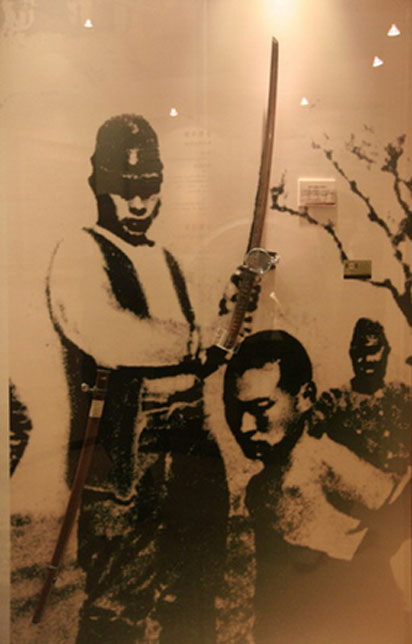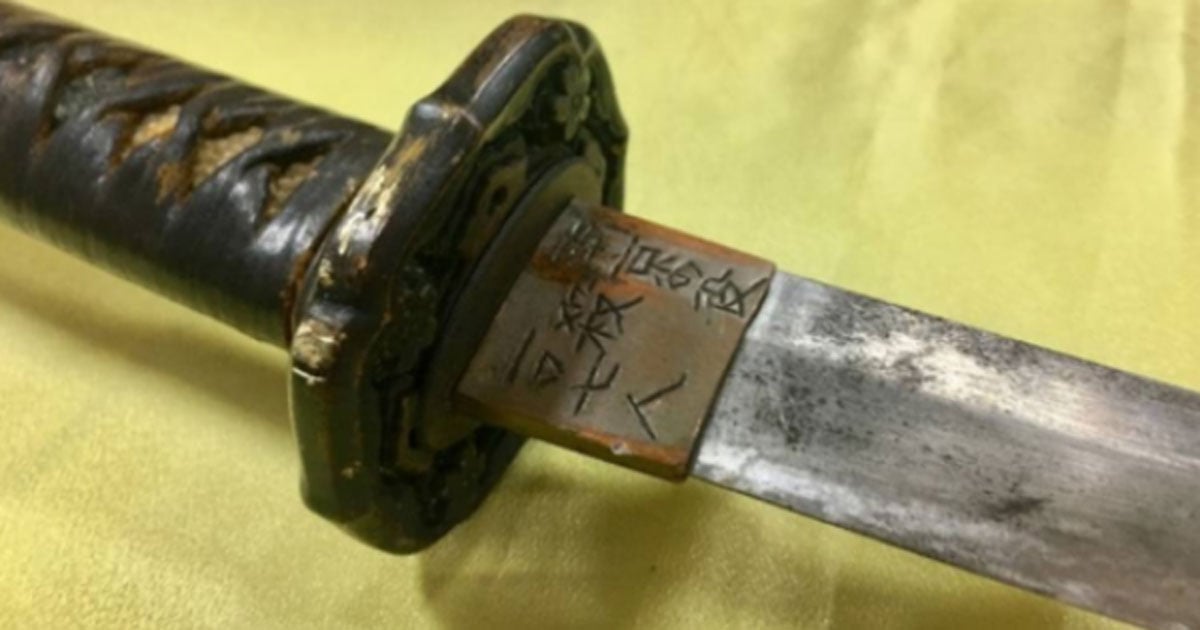Man Steals Samurai Sword From History Museum and Launches Attack Outside Taiwan Presidential Office
A Taiwanese man stole an antique samurai sword inscribed with the words “Nanjing battle, (this sword) killed 107 people” and used it to try to break into the Presidential Office, injuring a military police guard in the process.
Channelnewsasia reports that the man broke into a local history museum, smashed the display case holding the samurai sword with a hammer and then attempted to break his way into the presidential office in the center of Taipei. Carrying a Chinese flag and the samurai sword, he slashed a military police guard across the neck before being apprehended by police. The guard was rushed to hospital but is now in a stable condition.
Authorities say the samurai sword-wielding attacker, known only as Lu, had wanted to send a political message by flying the Chinese flag there. Taiwan is a self-ruling democracy, but China still sees it as part of its territory and Lu wanted to express his discontent with Taiwan’s President Tsai Ing-wen, who has refuted China’s claim to Taiwan.

The assailant was taken away by officers after the attack. (Photo: Focus Taiwan/Twitter)
Samurai Sword Carries Morbid Inscription with Death Count
The samurai sword that was stolen and used in the attack is inscribed with the words "Nanjing battle, (this sword) killed 107 people". The sword had been used by the Japanese military in the massacre of residents of the Chinese city of Nanjing in 1937.
The Battle of Nanking (or Nanjing) was fought in December 1937 during the Second Sino-Japanese War between the National Revolutionary Army of China and the Imperial Japanese Army for control of Nanking (Nanjing), the capital of the Republic of China. Following the capture of the city, Japanese soldiers massacred Chinese prisoners of war, murdered civilians, and committed acts of looting and rape in an event known as the Nanking Massacre. It is estimated that over 200,000 Chinese were killed in the incident.
The most notorious atrocity was a killing contest between two Japanese officers, which involved a race to see who could kill 100 people first using only a samurai sword. The event was covered much like a sporting competition with regular updates on the score over a series of days.
- The Amazing Story of Yasuke: The Forgotten African Samurai
- Samurai Secrets Revealed: English Translation of the 500-year-old ‘Sword Scroll’ Provides Fighting Tactics Including ‘Egg Them’
- The Brutality and Delicacy of Samurai Armor: Superior Protection with a God-like Aesthetic

Sword used in the "contest" on display at the Republic of China Armed Forces Museum in Taipei, Taiwan (public domain)
Japanese Samurais
The samurai class emerged around the 8th century. Up until that time, Japan’s imperial army was made up of conscripted peasants. This did not produce an effective military force. Separatists and independent tribes threatened the stability of the Empire as well as the safety of ordinary people. Unable to rely on the state military for protection, anyone with the means to do so (i.e. land owners and provincial lords) hired their own soldiers. “These forces, formed by provincial clan leaders, were basically private protection societies, miniature armies, adept at equestrian skirmishes. And although competitive with one another, they quickly saw the wisdom of forging strength-in numbers bonds” (Cotter, 2013). The word ‘samurai’ comes from an old Japanese verb ‘to serve.’ Over time, the authority of the Emperor waned and the power of the armed elite grew. By the 12th century, samurai working for shoguns were the ruling class of Japan.

An 1860 photo of a samurai warrior in complete armor ( Public domain )
Samurai Swords
The most popular sword wielded by the samurai was the katana sword, which is characterized by its distinctive appearance: a curved, single-edged blade with a circular or squared guard and long grip to accommodate two hands.
During the Meiji period (1868 – 1912), the samurai class was gradually disbanded, and the special privileges granted to them were taken away including the right to carry swords in public. Sword manufacture in Japan was banned in 1945 and many swords were confiscated and destroyed.
Most of the remaining samurai swords are now in private collections or displayed in museums, like the one stolen to carry out the recent attack in Taiwan.

Various samurai swords. Photo taken at the Victoria & Albert Museum, London. (Public Domain)
Top image: A Japanese samurai sword with Chinese script that reads "killed 107 people during the war in Nanjing, (China)" was used on Aug 18 by an attacker that slashed a military police guard at the Taiwan Presidential Palace. (Photo: STR/Taiwan's Central News Agency)

















